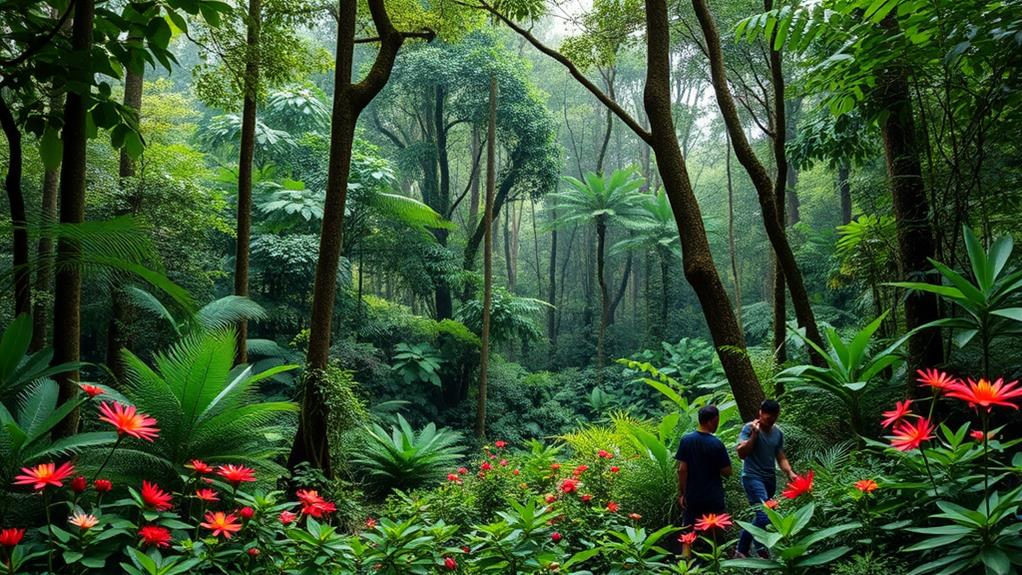The Philippines is home to over 3,100 endemic plant species. Among these unique plants are trees like the critically endangered Philippine Teak and the vulnerable Kalingag. The Philippine Teak is sought after for its high-quality timber, making it a target for illegal logging and deforestation. The Kalingag, on the other hand, is threatened by habitat loss due to agriculture and urban development. In addition to these trees, the Philippines is also known for its rich diversity of orchids, including the famous “queen of orchids,” the Waling-Waling. This vibrant flower is endemic to the Philippines and is highly prized for its beauty and rarity.
Endemic flowers thrive across diverse habitats. For example, Attenborough's Pitcher Plant plays a key role in local ecosystems.
More than 530 medicinal plants are integral to both traditional practices and modern healthcare.
Euphorbia hirta, for instance, is vital for treating ailments.
However, these plants face serious conservation challenges from habitat destruction and climate change. Understanding these factors is crucial for their preservation.
Overview of Philippine Endemism

The Philippines is home to a remarkable level of endemism, with a significant proportion of its plant species found nowhere else on Earth.
The country's rich biodiversity is characterized by over 9,250 vascular plant species, with approximately 3,100 species identified as endemic, meaning they're unique to the Philippines. This high level of endemism is particularly notable among tree species and medicinal plants.
For example, the Philippines is home to 150 unique palm species, with two-thirds of these palms found only in the archipelago.
The country's horticultural diversity is also highlighted by its impressive collection of orchid species.
Approximately 1,000 orchid species thrive in the region, with around 70% being restricted to the archipelago. These endemic species play a crucial role in the ecosystem, providing essential services and contributing to local culture and economy.
For instance, several medicinal plants endemic to the Philippines are utilized in traditional medicine, offering therapeutic benefits that are often unrecognized globally.
The conservation of these unique plant species is vital, as they face significant threats from habitat loss and climate change.
The Philippines' high level of endemism reinforces its status as a global biodiversity hotspot, accentuating the urgent need for effective conservation measures to protect these valuable resources.
Notable Endemic Trees
Endemic Trees in the Philippines
The Philippines is home to a diverse range of endemic trees, which are a vital component of the country's unique ecosystems. One such tree is the Philippine Teak (*Tectona philippinensis*), which is critically endangered and primarily found in regions like Lobo and San Juan in Batangas.
The Kalingag (*Cinnamomum mercadoi*) is another notable species that thrives at elevations of 300-2000 meters and depends on specialized hornbills for seed dispersal, making it vulnerable.
Conservation Status of Endemic Trees
The conservation status of these endemic trees is concerning. The following table provides an overview of their status:
| Tree Species | Conservation Status |
|---|---|
| Philippine Teak | Critically Endangered |
| Kalingag | Vulnerable |
| Narra (*Pterocarpus indicus*) | Near Threatened |
| Almaciga (*Agathis philippinensis*) | Vulnerable |
| Bagras (*Eucalyptus deglupta*) | Endangered |
Conservation Efforts
Sustainable management and conservation efforts are crucial to protect these endemic species and their habitats, ensuring the preservation of the Philippines' unique flora.
Unique Endemic Flowers

The Philippines is home to a diverse range of unique endemic flowers that significantly contribute to the country's biodiversity and ecological richness.
Diverse Habitats: These flowering plants thrive in various altitudinal ranges, from lowland forests to mountainous terrains. For example, the Philippine Teak (Tectona philippinensis) can be found in well-drained lowland forests, while the Attenborough's Pitcher Plant (Nepenthes attenboroughii) grows in the nickel-rich soils of Palawan's Victoria massif.
The unique adaptations of these flowers have led to Pollinator Relationships with specific insects and animals. The Philippine Teak, for instance, relies on bees and butterflies for pollination, while the Attenborough's Pitcher Plant obtains nutrients by capturing and digesting insects.
Unfortunately, many of these endemic flowers face threats, highlighting the need for Conservation Status efforts. The Philippine Teak is critically endangered due to habitat loss and logging, while the Attenborough's Pitcher Plant is vulnerable to nickel mining and habitat degradation.
Conservation is essential to preserve their unique genetics and roles in the ecosystem. The floral diversity in the Philippines is crucial for ecological balance, and preserving these unique endemic flowers is vital for maintaining the country's rich biodiversity.
Medicinal Plants of the Philippines
The Philippines is home to over 530 medicinal plant species, which play a vital role in both traditional and modern healing practices. Two of the most frequently cited species for their therapeutic properties are Euphorbia hirta L. and Psidium guajava L. This rich diversity includes 28 threatened species, with 11 being endemic to the Philippines, highlighting their economic importance in local healthcare.
Leaves are commonly used in medicinal preparations, particularly for oral administration, and are effective in addressing digestive ailments such as diarrhea.
Ethnobotanical studies have revealed a deep-rooted reliance on these medicinal plants by indigenous and non-indigenous populations, especially in Mindanao.
Understanding the pharmacological potential of these species not only supports traditional practices but also opens avenues for modern medicine.
Conservation of threatened and endemic plant species is crucial to ensure their continued availability. By promoting sustainable use and preservation of these medicinal plants, future generations can benefit from their healing properties.
Conservation Challenges and Efforts

The Philippines' unique flora faces significant conservation challenges, with many species on the brink of extinction.
The Philippine Teak (Tectona philippinensis) and Attenborough's Pitcher Plant (Nepenthes attenboroughii) are critically endangered due to habitat conversion, logging, and poaching. The lack of legal protection for many plant species native to the archipelago exacerbates these threats.
Habitat loss, illegal wildlife trade, and climate change are the main threats to conservation efforts.
Habitat loss occurs due to agricultural expansion and deforestation, leading to the destruction of natural habitats.
The illegal wildlife trade, including the poaching of rare species, further endangers the survival of these plants.
Climate change also impacts ecosystems and species viability, making conservation even more challenging.
Conservation initiatives, such as establishing protected areas and community-based programs, are essential for safeguarding endemic flora.
These efforts aim to mitigate threats, promote sustainable practices, and enhance legal frameworks.
By supporting these initiatives, we can help protect the Philippines' invaluable plant diversity for future generations.
A collaborative approach, engaging local communities and fostering environmental awareness, is crucial for ensuring the survival of these unique species and their habitats.
Questions and Answers
What Are the Philippine Endemic Medicinal Plants?
Philippine Endemic Medicinal Plants
The Philippines is home to a diverse range of endemic medicinal plants, which have been used for centuries in traditional healing practices.
Euphorbia hirta and Psidium guajava are two examples of these plants, which are commonly used to treat digestive issues.
These medicinal plants play a crucial role in the country's traditional medicine, and it's essential to conserve and preserve them to ensure their sustainable use.
Many of these species are threatened, and understanding their ecological roles and medicinal properties is vital for maintaining biodiversity.
Conservation of these plants is critical, as it ensures the continued availability of these valuable resources for future generations.
What Are the 10 Endemic Plants in the Philippines?
The Philippines is home to 10 endemic plant species that play a vital role in maintaining biodiversity hotspots and ecological health.
Two of these species, the Philippine Teak and Attenborough's Pitcher Plant, are critically endangered and exhibit unique adaptations. The Philippine Teak, for instance, has a remarkable ability to grow up to 40 meters tall, making it one of the tallest trees in the country.
Attenborough's Pitcher Plant, on the other hand, has evolved a carnivorous nature, obtaining essential nutrients by capturing and digesting insects.
Each of these endemic plants holds significant cultural value, contributing to local traditions and ecological balance. For example, the Philippine Teak is highly valued for its durable wood, which is often used in traditional furniture-making.
Moreover, these plants support regional ecosystems by providing shelter and food for various animal species.
Understanding the importance of these plants highlights the urgency of conservation efforts to protect them. These efforts are crucial to ensure the continued survival of these vital resources in their natural habitats, ultimately supporting the health of regional ecosystems.
What Trees Are Endemic in the Philippines?
The Philippines is home to unique and rare tree species that are essential for local ecosystems.
Two examples of these endemic trees are the Philippine Teak and Kalingag.
These trees support biodiversity and provide habitats for various wildlife, making them crucial components of their ecosystems.
Conservation efforts are necessary to protect these trees from threats such as deforestation and overharvesting.
Understanding the importance of these trees can help appreciate the need to preserve them for future generations.
What Are the Abundant Medicinal Plants in the Philippines?
The Philippines is home to a rich variety of medicinal plants, often used in traditional remedies.
Euphorbia hirta L. and Psidium guajava L. are two prominent examples, known for their therapeutic benefits.
In herbal preparations, leaves are commonly used in oral administration.
Sustainable harvesting practices are crucial to ensure these resources remain available, as many species are threatened.